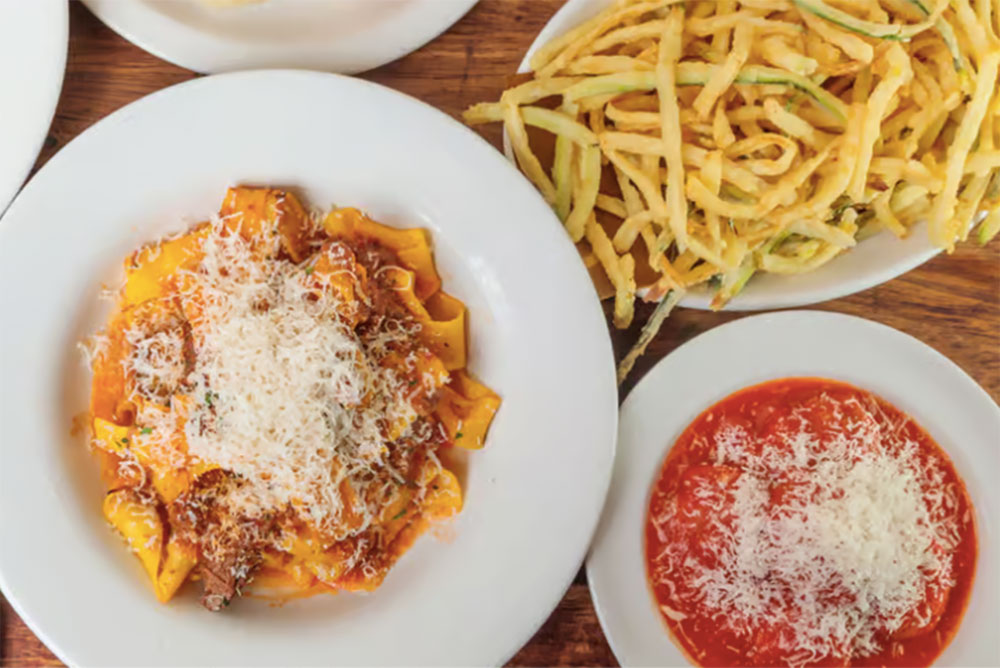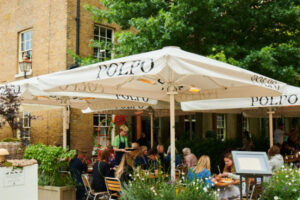
A selection of Venetian bacaro plates from the Polpo restaurant website. On the front: Cover of Polpo: A Venetian Cookbook (of Sorts); Venetian ceiling photo from the book, by Jenny Zarins.
By Nancy Pollard
After owning one of the best cooking stores in the US for 47 years—La Cuisine in Alexandria, Virginia—Nancy Pollard writes Kitchen Detail, a blog about food in all its aspects—recipes, film, books, travel, superior sources, and food-related issues.
 I am a late-in-life convert to bar-hopping, something I loathed in my impetuous youth, despite my friends’ wholehearted embrace of the tradition. They were able to look past the cheap alcohol, rancid peanuts and processed cheese goldfish crackers always on offer. I just couldn’t.
I am a late-in-life convert to bar-hopping, something I loathed in my impetuous youth, despite my friends’ wholehearted embrace of the tradition. They were able to look past the cheap alcohol, rancid peanuts and processed cheese goldfish crackers always on offer. I just couldn’t.
But bar-hopping in Venice? This is a totally different thing, as I happily discovered with my daughters and husband in recent years. I’m 100 percent on board. And Russell Norman has captured it beautifully in his cookbook, guide and sort of autobiography, Polpo. Titled after his collection of restaurants-bars with snacks, this indispensable book will help steer you toward bar-hopping magnificence, reaching well beyond Norman’s own establishments. Polpo has a couple of locations in London, and you can check out their very helpful website here.
The Joys of Bacari Over Bars
Norman will lead you through the pretty, modest, little bàcari (pronounced BOK-uh-ree) of Venice, where you can enjoy an aperitivo or a glass of local wine and eat simple but delicious snacks, cichèti (think tapas). Not only does he give you a good list of bacari to search out, but his writing style is so inviting, you can feel the atmosphere of each bacaro from the text. He includes easy recipes that allow you to reproduce tasty bites for your own aperitivo hour or make several platters (really quite easy with this cookbook) and just stage a bacari buffet. And should you go to Venice—as you should—take Norman’s guide not only for the bacari suggestions, but also for his thoughtful ideas on how to avoid the incredible crowds that are endemic to this magical city.
A Meal From Polpo
 But back to the cookbook part, named after his London restaurants—and be advised that, as with many restaurant cookbooks, sometimes the ingredient list and directions are a bit off). You have to use your cooking common sense when you choose through his selection of appetizers, mains, desserts, and drinks. Below are three of my current favorites, which I have tweaked slightly as common sense dictated. The salad is a stunner and can be served as a first course, or even as a main course if you have used some of his appetizer ideas based on Italian crostini. The mozzarella bites are great for kids and their parental units alike. The orange cake has a most unusual setup in how you use the oranges and their syrup, and the cake lasts for several days in a most delicious state.
But back to the cookbook part, named after his London restaurants—and be advised that, as with many restaurant cookbooks, sometimes the ingredient list and directions are a bit off). You have to use your cooking common sense when you choose through his selection of appetizers, mains, desserts, and drinks. Below are three of my current favorites, which I have tweaked slightly as common sense dictated. The salad is a stunner and can be served as a first course, or even as a main course if you have used some of his appetizer ideas based on Italian crostini. The mozzarella bites are great for kids and their parental units alike. The orange cake has a most unusual setup in how you use the oranges and their syrup, and the cake lasts for several days in a most delicious state.
Warm Squid Salad With Cavolo Nero & Chickpeas

- 1 large bunch or two small ones of cavolo nero (lacinato or dinosaur kale are frequent names for this green)
- 1 pound cleaned squid with tentacles (you can often find this frozen)
- Best olive oil for finishing, plus one you use to sauté
- Fleur de sel or Maldon sea salt and freshly ground black pepper
- 3 garlic cloves, peeled, germ removed if necessary, and finely chopped
- 1 red chili pepper, seeded, membrane shaved off, and finely sliced
- 5 medium tomatoes, quartered, seeds and juice removed, and roughly chopped
- 14 ounces chickpeas, soaked overnight and then cooked in salted water or broth until tender (but not mushy)
- ¼ cup white wine
- Remove the stems from the cavolo nero. Blanch the leaves in boiling salted water for two minutes and then refresh in ice water. Drain and roughly chop the leaves.
- Cut the squid bodies into 1/3-inch rings, the tentacles into two lengthwise pieces.
- Pour enough of your frying olive oil to film the bottom of your fry pan and allow to get hot before adding the squid, salt, pepper, garlic, and chili.
- Add the tomato, cavolo nero, and chickpeas and fold to mix with your spatula.
- Add some of the wine and sauté over high heat for no more than two minutes.
- The greens should have thoroughly wilted and the wine almost disappeared.
- Remove from heat, divide on salad plates, swizzle on your best finishing olive oil, check for seasoning, and serve immediately.
- You can prepare the squid; precook the greens and the chickpeas; prep the tomatoes, garlic, and chili ahead and then do the cooking before you want to serve. Serving it at room temperature is fine if you want to have a first course before.
Mozzarella Bocconcini

- 2¾ ounces (80gr) panko bread crumbs
- Zest from 1 lemon
- Italian Tipo 00 all-purpose flour with some salt added
- Small handful of fresh oregano leaves, chopped
- 1 medium to large organic egg
- 8 ounces buffalo mozzarella (I like using the small balls or bocconcini and cut them in half)
- Grapeseed oil or other vegetable oil for frying
- Mix the panko with the zest and oregano in a dish.
- In a second dish beat the egg really well with a fork.
- Put the salted flour in a third dish.
- Take a piece of mozzarella (should be around 1 to 1½ inch in diameter) and roll it first in the salted flour, then in the beaten egg, finally in the panko mixture. You can do this several hours before frying if you store the coated mozzarella in the fridge. Bring the cheese to room temperature before frying.
- Heat your oil in a deep pan (just enough oil so that the mozzarella pieces float). The oil should be between 350 and 365F max.
- Fry a few mozzarella balls at a time, so that the temperature does not fluctuate too much. Fry until they are golden brown.
- Drain the mozzarella balls on paper and serve.
- We carried a marvelous restaurant-quality panko at the late lamented La Cuisine, but a really good cooking client discovered the panko from www.uppercrustent.com and I am won over.
- You can make a marinara or pesto dipping sauce if you like. Just have more napkins!
Flourless Orange and Almond Cake

- 2 thin-skinned oranges.
- 3½ ounces (100gr, or ¾ cup) light muscovado sugar
- 2 cups (400gr) caster or superfine sugar
- 6 medium organic eggs or 5 large
- 8¾ ounces (250 gr) ground almonds
- 1½ teaspoons baking powder
- Zest and juice of 1 orange
- Norman suggests a 10-inch cake pan, but a 9-inch gives you a higher cake, which I prefer.
- Grease the pan with oil and line the bottom with parchment. Grease the parchment and you can film the interior with almond flour, which gives the cake a nice finish, but this is optional.
- Place the oranges in a saucepan with plenty of water to submerge the oranges. Simmer the oranges for two hours. Reserve the cooking liquid for a syrup later and allow the oranges to cool.
- In a food processor, add all the muscovado sugar and half the caster sugar, add the eggs, and whip until creamy.
- Cut the cooled oranges into medium-sized pieces and remove seeds before adding them to the processor.
- Pulverize the oranges into the batter and then add the ground almonds and baking powder; process briefly to combine and pour the batter into your cake pan.
- My cake was done after 50 minutes, even though Norman suggests up to 1 hour and 30 minutes. The cake is done when the internal temperature is about 205F or if a cake tester/skewer comes out clean.
- Now pour the reserved cooking liquid from the simmered oranges into a pan that can hold hold at least 4 cups. You should have about 3½ cups liquid (you may have to add water).
- Add the remaining caster sugar, the orange zest and juice. Bring to a fierce boil until you get a thick syrup. This can take about 15 minutes or more.
- Serve slices of the cake with the syrup plus whipped cream or mascarpone cream.
- Norman mixes mascarpone with whipped cream to serve, but it is delicious with a complementary ice cream as well.


The first two recipes look a bit labor intensive to me. But might actually try the orange cake. Also seems like a decent Passover recipe, except for the baking powder. But generally, separating the eggs gives the lift needed. Thx!